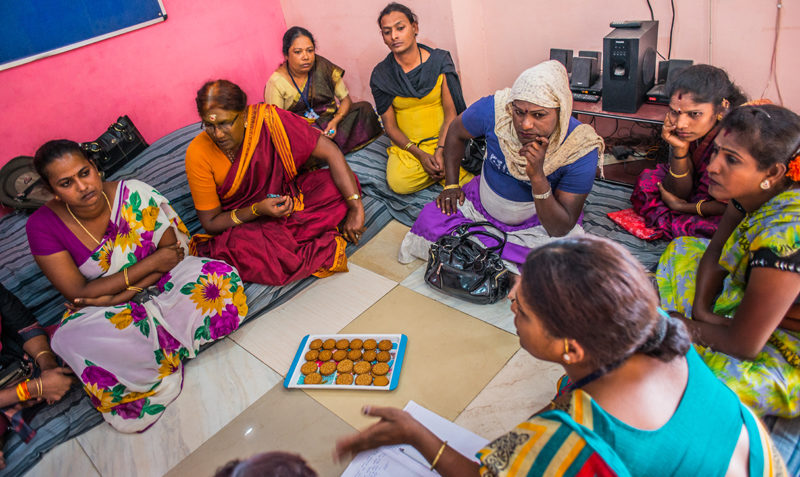Why it’s time to change perspective on HIV prevention
 © Gitika Saksena for Frontline AIDS
© Gitika Saksena for Frontline AIDS
HIV prevention must be re-orientated so that it places people (rather than interventions or disease) at the centre of the response.
By Marija Pantelic, the Alliance’s senior advisor for research and evaluation
HIV prevention stands at a crossroads between unprecedented opportunity and crisis. Biomedical advances such as treatment-as-prevention and pre-exposure prophylaxis (PrEP) offer huge promise for preventing new HIV infections, making the end of AIDS possible, at least in theory.
But access to, and uptake of, these technologies remain unacceptably low in some settings. In 2016, approximately 1.6 million adults were newly infected with HIV. While this is 10.6% fewer than in 2010, it is far from the 50% reduction agreed by many countries in 2011. Globally, 45% of all new HIV infections occur among sex workers, men who have sex with men, and people who inject drugs (often referred to as key populations). Yet new infection rates have not declined among these groups in many countries and in some contexts they are rising.
Approaches to HIV prevention need to change. In a special issue of the Journal of the International AIDS Society (JIAS) we are calling for a shift in perspective within HIV prevention programmes and research, whereby people are recognised for their agency rather than assumed to be passive beneficiaries or research participants.
HIV prevention must be re-orientated so that it places people (rather than interventions or disease) at the centre of the response.
Ultimately, people have a wealth of experience in manoeuvring their lives. At the core of person-centred HIV prevention is the acknowledgement that people are best placed to decide which prevention methods are appropriate and effective in their current circumstances. It also recognises that a person’s needs change over time and are shaped by a range of factors, some of which are personal (such as their gender identity and profession), some of which are contextual (such as their location and economic status) and some of which are structural (such as their experiences of stigma, violence and criminalisation).
Ultimately, people have a wealth of experience in manoeuvring their lives.
Person-centred HIV prevention programmes
While person-centredness is not a new concept, adapting the delivery of HIV programmes to individual needs is a departure.
While differentiated services, which categorise (and sometimes assume) people’s needs based on factors such as their treatment status or age, are an important step in the journey towards more responsive and customised offerings, they are still intervention- and risk-focused. A person-centred approach goes one step further by aiming to respond to the needs of an individual, rather than a sub-group.
Evidence on person-centred HIV prevention programming is scarce, but emerging studies suggest it could help reach the most marginalised people who may be vulnerable to HIV for many reasons but are not being reached through public health systems.
For example, in the JIAS commentary we share details of Women Initiating New Goals of Safety (WINGS), an individualised approach that has been effective in reducing various forms of gender-based violence experienced by women who use drugs in the United States, Kyrgyzstan and India. WINGS employs a non-judgmental stance to meet women where they are with respect to their intimate relationships. It enables them to set and enact their own goals to improve their relationship safety, based on whether they wish to stay with or leave their partner.
Making HIV prevention research more person-centred
Community-based participatory research, which involves planning, executing and disseminating research with the people who are being studied, is the most effective method for evaluating and informing person-centred HIV prevention.
Networks of key populations and people living with HIV, community groups, women’s rights groups and community activists can play instrumental roles in this by posing difficult ethical questions, identifying relevant community partners, and ensuring research is conducted in a way that maintains accountability to communities.
This approach can and should be applied across quantitative as well as qualitative research, including randomised controlled trials. But there is also a need to expand the focus of enquiry to the whole person, rather than just focusing on the impact of an intervention on HIV status or risk.
A person-centred study would also examine the wider aspects of people’s everyday lives that might have the potential to strengthen HIV prevention.
For example, it is possible for a study concerned with biomedical HIV prevention to follow good participatory practice guidelines but focus only on clinical outcomes such as condom use or reduction in viral loads. In contrast, a person-centred study would also examine the wider aspects of people’s everyday lives that might have the potential to strengthen HIV prevention. The outcomes measured should reflect what matters to the end users, even if this entails a departure from what is normally considered as relevant to public health, such as sexual pleasure.
Changing the way HIV prevention research is reported
Embracing community-based participatory approaches as the gold standard for HIV prevention research requires a systemic shift in reporting methods.
At present, guidelines on how to report research on randomised controlled trials and observational studies in leading scientific journals do not include requirements to report on community involvement. Journals such as JIAS are uniquely positioned to change this by altering their guidelines, which would catalyse a cultural change in how HIV prevention research is conceived and reported.
A more sustainable HIV response
Taking a person-centred approach to HIV prevention services and research, one in which individuals actively participate, has the potential to unlock a more sustainable response to HIV.
It is only by tapping into the resourcefulness, resilience and knowledge of people and communities that programmes and research will become more relevant, appropriate and effective.
See also our case study Opening up spaces for transgender communities in India for an illustration of what a person-centred approach can look like.
This article was written as the International HIV/AIDS Alliance, before we changed our name to Frontline AIDS.
Tags
HIV preventionResearch


